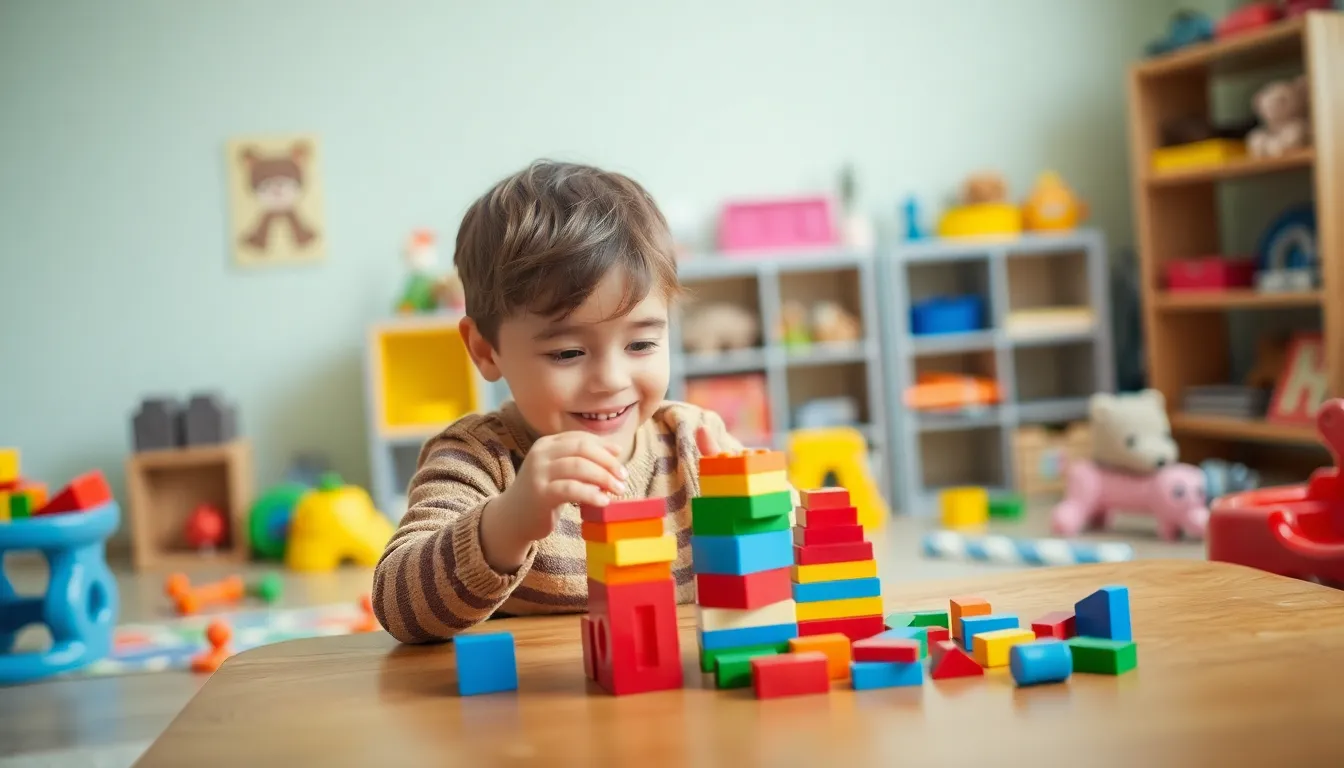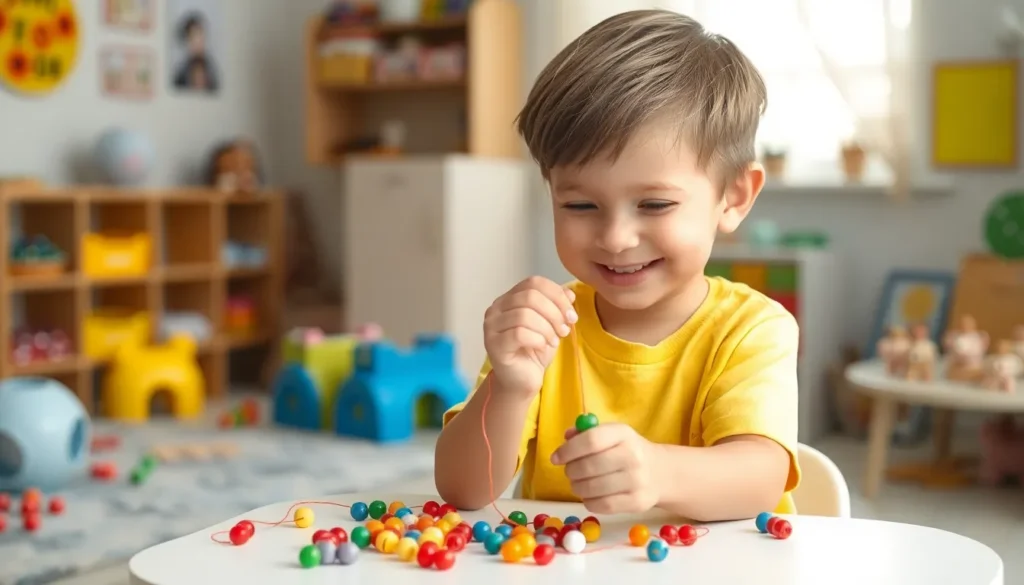Table of Contents
ToggleFine motor skills play a crucial role in everyday life, impacting everything from writing to playing musical instruments. These skills involve the coordination of small muscles in the hands and fingers, allowing individuals to perform precise movements. Mastering fine motor skills is essential for children as they develop independence and confidence in their abilities.
As children grow, fine motor skills help them engage in activities like drawing, cutting, and buttoning clothing. These skills not only enhance their physical capabilities but also support cognitive development and social interactions. Understanding the importance of fine motor skills can empower parents and educators to create enriching environments that foster growth and development in young learners.
Understanding Fine Motor Skills
Fine motor skills involve the precise coordination of small muscles, particularly in the hands and fingers. These skills are crucial for various daily activities, influencing children’s independence and confidence as they grow.
Definition and Importance
Fine motor skills refer to the ability to perform tasks that require the coordination of small muscle groups. Key activities that depend on fine motor skills include writing, buttoning clothing, and manipulating small objects. These skills are not only essential for practical tasks but also play a significant role in cognitive development by enhancing problem-solving abilities and encouraging creativity. Research indicates that strong fine motor skills contribute to improved academic performance, especially in areas like writing and art (American Academy of Pediatrics).
Developmental Stages
Children develop fine motor skills through distinct stages, each marked by specific milestones.
- Infancy (0-12 months): Grasp reflexes emerge, leading to the ability to hold objects. By six months, babies can typically pass objects from hand to hand.
- Toddlerhood (1-3 years): Toddlers start using pincer grips, allowing them to pick up small items like Cheerios or blocks. They also engage in simple drawing and coloring.
- Preschool (3-5 years): Children refine their dexterity, using scissors, completing puzzles, and manipulating small toys. They can draw shapes and begin to write letters.
- Early Childhood (5-7 years): Fine motor skills advance significantly during this period. Children can tie shoelaces, write their names, and participate in activities like painting and crafting.
Supporting these developmental stages through play and structured activities encourages the growth of fine motor skills, which lays a foundation for independence and competence.
Factors Affecting Fine Motor Skills

Fine motor skills development depends on various factors. These influences can either enhance or hinder a child’s ability to perform precise movements.
Genetic Influences
Genetic factors play a crucial role in fine motor skills development. Certain inherited traits can impact dexterity, hand-eye coordination, and overall motor performance. For example, children with a family history of motor skill challenges may face similar difficulties. Studies indicate that genetic predisposition can affect muscle tone and control, influencing how children grasp and manipulate objects. Understanding these hereditary factors allows parents and educators to tailor support based on individual needs.
Environmental Factors
Environmental factors significantly impact fine motor skills development. Access to stimulating and age-appropriate activities fosters skill progression. For instance, engaging in play that promotes hand use—such as building blocks, puzzles, or arts and crafts—actively enhances dexterity. Additionally, the availability of diverse tools, like scissors and crayons, encourages experimentation with hand movements. An enriched environment also includes opportunities for social interaction, as collaborative play can motivate children to practice their skills in a supportive setting. Moreover, nutrition and health status directly influence physical development, which can also affect fine motor coordination.
Activities to Enhance Fine Motor Skills
Engaging children in activities that promote fine motor skills development is crucial. Various play-based methods and everyday tasks can effectively build these skills.
Play-Based Learning
Play-based learning offers enjoyable ways to foster fine motor skills. Activities include:
- Building blocks: Manipulating blocks encourages hand-eye coordination and finger dexterity.
- Arts and crafts: Cutting, gluing, and coloring strengthen hand muscles and improve grip.
- Puzzles: Assembling puzzles enhances spatial awareness and precision.
- Play-dough: Molding and shaping play-dough exercises the fingers and develops tactile sensitivity.
- Stringing beads: This activity promotes concentration and improves finger strength.
Incorporating these activities into playtime not only makes learning fun but also supports essential skill development.
Everyday Tasks
Everyday tasks present valuable opportunities for fine motor skills enhancement. Parents and caregivers can integrate these tasks into routines:
- Buttoning clothing: Fastening buttons helps refine pincer grip and coordination.
- Zipping up jackets: Using zippers promotes hand strength and control.
- Pouring liquids: Transferring water or sand between containers enhances stability and precision.
- Brushing teeth: Holding a toothbrush develops wrist rotation and grip control.
- Preparing food: Simple tasks like stirring ingredients or tearing lettuce involve various hand movements.
Encouraging children to participate in these tasks fosters independence while strengthening their fine motor skills in practical ways.
Assessing Fine Motor Skills
Assessing fine motor skills involves a combination of standardized tests and observational methods. These approaches provide valuable insights into a child’s motor abilities and areas needing improvement.
Standardized Tests
Standardized tests assess fine motor skills in a controlled environment, yielding quantifiable results. Examples include the Peabody Developmental Motor Scales and the Bruininks-Oseretsky Test of Motor Proficiency. These tests evaluate tasks like grasping, hand-eye coordination, and manipulation. Each test offers norms based on age, enabling comparison against peers. Results can inform tailored interventions to support skill development.
Observational Methods
Observational methods involve monitoring a child’s performance during daily activities. This approach allows for assessment in natural settings, revealing fluid competence in real-life tasks. Parents and educators can document specific skills such as drawing, cutting with scissors, and manipulating small objects. Structured checklists and rating scales assist in tracking progress over time. Observations highlight strengths and weaknesses, guiding focused development strategies.
Fine motor skills are vital for children’s growth and independence. They lay the foundation for everyday tasks and foster confidence in various activities. By engaging children in play-based learning and providing opportunities for skill development, parents and educators can significantly enhance these essential abilities.
Recognizing the factors that influence fine motor skills, including genetics and environment, allows caregivers to create supportive surroundings. With the right encouragement and resources, children can master these skills, paving the way for future success in both academic and social settings. Investing time in fine motor skill development is an investment in a child’s overall well-being and potential.





